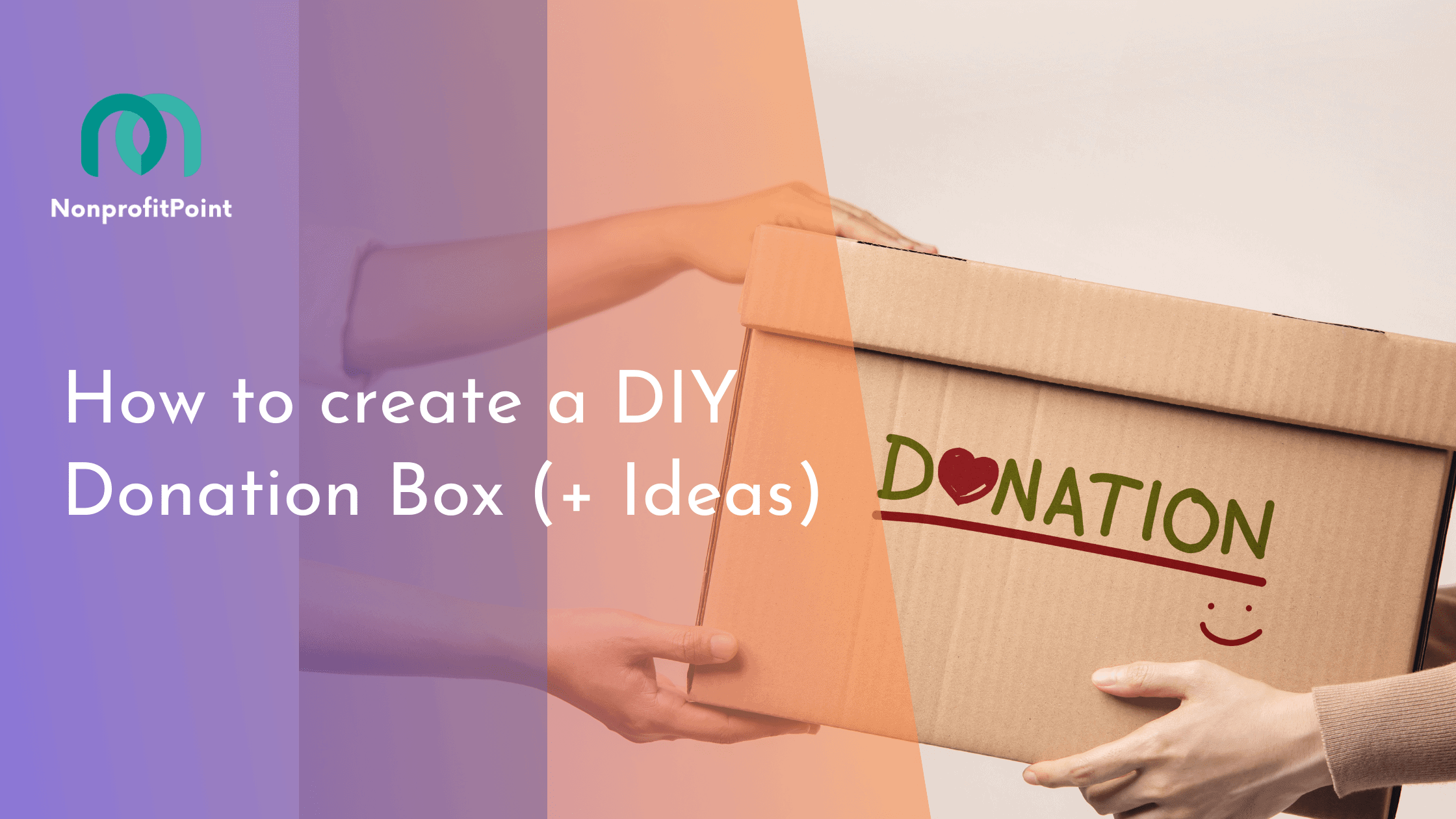How to Create a DIY Donation Box (+10 Ideas to Get Inspired)
In an age where community engagement and collective aid are not just valued but vital, crafting a DIY Donation Box is a small, enchanting gesture that weaves a thread of goodwill and kindness through the fabric of society. This magical vessel of generosity doesn’t simply collect spare change; it’s a beacon, calling forth the spirit of sharing and illuminating the altruistic corners of the human heart, creating ripples of benevolence that extend far beyond its humble confines.
Our guide to sculpting your own DIY Donation Box is not merely a set of instructions; it’s an invitation to participate in a broader narrative of compassion and mutual assistance. Whether for a school fundraiser, a local shelter, or a global cause that tugs at your heartstrings, this box stands as a testament to the power residing in small, intentional acts of love.
With materials easily found and a design limited only by your imagination, this endeavor is accessible and profoundly rewarding, beckoning readers like yourself to explore, craft, and ultimately contribute to the silent symphony of goodwill echoing through our communities. So, let’s embark on this journey of creating not just a box, but a sanctuary for hope and charity, shall we?
Here’s how to make a simple DIY Donation Box:
Materials Needed
- Sturdy cardboard box or an old shoe box
- Wrapping paper or acrylic paint
- Glue (craft glue or hot glue gun)
- Double-sided tape
- Scissors or utility knife
- Decorative materials: stickers, markers, printed labels
- Ruler
- Optional: lock, seal, rubber feet, felt or lining material
Step 1: Prepare the Box

First, select an appropriate box. A cardboard or shoe box works perfectly due to its lightweight and sturdy nature. The box should be clean, dry, and free of any damages or odors. If you are repurposing a shoe box, reinforce the corners and edges with some craft glue or hot glue to ensure it’s sturdy.
If the box has any labels, stickers, or prints on it, make sure to remove them thoroughly to have a clean canvas for decoration. In case of residue, use a mild adhesive remover but ensure the box is dry before proceeding.
Step 2: Cut a Slot

Determining the size of the slot is crucial. For a universal slot accommodating both coins and bills, make it around 1/8″ wide and at least 5-6″ long. With a ruler, measure and mark the dimensions of the slot on the top or lid of the box.
For precision, use a utility knife (with caution) to cut along the marked lines. If using scissors, puncture a hole within the marked area first, then insert the scissors and cut along the lines. Round the corners of the slot slightly to avoid sharp edges.
Step 3: Decorate the Box
Now, unleash your creativity! You might opt for wrapping paper, fabric, or paint to cover the box. If you choose wrapping paper or fabric, measure and cut enough material to cover the box entirely. Use craft glue or double-sided tape to adhere the material, smoothing out wrinkles and bubbles as you go.
For those painting the box, acrylic paints are ideal; apply with a brush or sponge, allowing each coat to dry fully before adding another. Consider using stencils or stickers to create designs, logos, or messages relevant to your cause.
Step 4: Add Details
Details are vital in communicating the purpose of the donation box and encouraging contributions. Craft a succinct yet compelling message that informs and inspires.
For example, if the box is for a school fundraiser, add details about what the funds will be used for. You might also add images, stickers, or symbols related to your cause. If you can, incorporate bright colors and large, legible fonts to make the box more eye-catching and readable from a distance.
Step 5: Secure the Box
Security for the donations is essential. You can create a simple latch and lock mechanism, or use security seals or tamper-evident tapes that show if the box has been opened.
If you’d like to add feet to the box for stability, find small rubber or silicone bumpers, and adhere them to the bottom corners of the box. These will prevent slipping or sliding on smooth surfaces.
Step 6: Set Up the Box
Select a strategic location for your donation box, where it’s easily visible and accessible, yet secure. If it’s for a store or business, place it near the cash register or exit, where patrons can easily see and access it. If it’s for an event, find a central location where attendees frequently pass by.
Always obtain permission from the owner or manager of the location before placing your donation box, and consider monitoring it regularly to ensure its security and to collect donations
Customization Ideas
- Holiday-Themed: Craft your box to match holiday themes or special events.
- Interactive Elements: Incorporate small, engaging elements, like a spinning wheel or trivia, that draw attention and encourage donations.
- Transparency: Use a section of clear acrylic or plastic, allowing people to see donations accumulate, fostering a sense of collective effort.
- Tech-Savvy: Implement a QR code linking to your cause’s website or a digital donation platform, providing an alternative for non-cash donors.
Remember, the key to a successful donation box isn’t just its physical allure but also the emotional appeal and transparency of your cause. Happy crafting, and best of luck with your fundraising efforts!
Now let’s head on to some creative DIY Donation Box Ideas:
1. Eco-Friendly Green Box
The Eco-Friendly Green Box is a celebration of sustainability, crafted entirely from recycled materials. Begin with a sturdy base, like a reclaimed cardboard box, and then collage its exterior with a vibrant array of meticulously cut-out images and words from old magazines, newspapers, or eco-friendly paint.
Emphasize messages and imagery that advocate for environmental conservation and green living. The tactile and visual texture this creates will not only draw eyes but also spark conversations about the importance of protecting our planet. Ensure to use eco-friendly adhesive to keep the box in alignment with its environmental theme.
2. Wishing Well Box
A Wishing Well Box offers a tactile and engaging donating experience. Construct the well using wooden planks or durable cardboard, creating a cylindrical or square structure. Paint the exterior with colors that exude tranquility and hope, perhaps a blend of serene blues and greens.
Attach a roof-like structure at the top and a sign that reads, “Make a Wish for a Better World.” The whimsical design encourages donors to pause, reflect, and make a wish as they contribute, fostering a deeper connection between the donor and the cause.
3. Piggy Bank Giant
Take the traditional piggy bank concept and enlarge it to craft the Piggy Bank Giant. Utilize materials like papier-mâché to form the body of the pig, incorporating a slot large enough for both coins and bills.
The pig should be painted in bright, cheerful colors, with a finish that is both eye-catching and inviting to touch. This approachable, familiar design is instantly recognizable, sparking nostalgia and appealing to donors of all ages, making it a fantastic option for community or school fundraising events.
4. Light-Up Donation Box
Illuminate the spirit of giving with the Light-Up Donation Box. Start with a standard box structure, then integrate LED strip lights or battery-operated fairy lights into the design.
The lights can be arranged to frame the donation slot or to illuminate the entire box. With each donation received, the box would light up for a few seconds, serving as a delightful acknowledgment of the donor’s contribution. This visual feedback not only thanks the donor in real time but also attracts the attention of others in the vicinity, promoting further donations.
5. Themed Treasure Chest
Craft a captivating Themed Treasure Chest to entice adventurous donors. Using wood or sturdy cardboard, construct a box that mimics the appearance of a classic pirate treasure chest with a hinged lid. Decorate it with gold paint, faux jewels, and iconic pirate imagery like skulls and crossbones.
Consider lining the interior with red or black velvet for an added touch of luxury and mystery. This whimsical, interactive donation box is sure to intrigue and attract donors, making them feel like they’re contributing to a valuable treasure trove for your cause.
6. Seasonal Harvest Basket
Harness the charm and abundance of the autumn season with the Seasonal Harvest Basket. Begin with a sturdy, deep wicker or wire basket as your base. Embellish the exterior with artificial autumn leaves, pine cones, and miniature pumpkins or gourds, securing them with hot glue or wire.
These decorations should evoke the warmth and richness of harvest time, creating a visual connection with themes of sharing and bounty. For an extra layer of allure, intertwine battery-operated LED fairy lights among the fall decor, casting a soft glow that invites potential donors closer.
7. Interactive Puzzle Box
The Interactive Puzzle Box adds an engaging twist to the donation process. Construct a basic box from wood or thick cardboard, then adhere a simple, handcrafted puzzle or maze onto one side. The puzzle could be a sliding tile, labyrinth, or a straightforward jigsaw.
Design it in a way that donors can manipulate or solve the puzzle as they approach to make a donation. This interactive element offers a moment of play and enjoyment, making the donation experience memorable and distinctive, thus encouraging passersby to participate and donate.
8. Transparent Community Jar
Visualize collective effort and progress with the Transparent Community Jar. Use a sizeable transparent container—glass or sturdy plastic—as the receptacle for donations. The transparency allows donors to see their contributions joining others, physically building up over time.
Attach a label or sign with information about the fundraising goal and the cause supported. As the jar fills, the growing pile of donations serves as a visual testimony to the power of community giving, inspiring others to add to the collective effort.
9. Retro Telephone Booth
Embrace nostalgic appeal with a Retro Telephone Booth donation box. Craft this from red-painted wood or cardboard, modeling it after the iconic British telephone booths.
The vivid red color, paired with clear signage explaining your cause, immediately catches the eye. Incorporate a slot for donations at a convenient height, inviting people to “answer the call” for help or support. This creative design not only stands out but also taps into a sense of global connection and assistance.
10. Travel Suitcase Box
For causes related to education, travel, or international aid, consider the Travel Suitcase Box. Repurpose a small, old suitcase or craft one from materials like wood or thick cardboard. Decorate the exterior with travel stickers, labels, or stamps from various countries, creating a vintage or well-traveled look.
Attach a sturdy handle for ease of transport and a slot for donations. This design subtly communicates adventure and global solidarity, making it particularly poignant for fundraisers that aim to broaden horizons or provide aid across borders.
Each of these ideas offers a unique perspective, aiming to make the donation process engaging and visually compelling. These creative boxes not only serve as collection points but also as conversation starters, raising awareness for your cause in a way that’s both playful and profound. Happy crafting!
When crafting a DIY donation box, having a checklist of handy tips can dramatically simplify the process and enhance the appeal of the finished product.
Below are some insightful tips that are user-centric, shareable, and exceedingly helpful:
Design & Construction Tips:
- Visual Appeal:
- Select colors and designs that align with and promote the message of your cause. Vibrant, eye-catching colors tend to draw more attention.
- Consider incorporating your organization’s logo or mascot into the design.
- Material Choice:
- Opt for durable, lightweight, and inexpensive materials. Consider the environment where the box will be placed, and choose materials that suit the conditions (indoor, outdoor, humid, dry, etc.).
- Interactive Elements:
- Adding interactive components can engage donors, but ensure they are straightforward and accessible to people of all ages.
Functional & Practical Tips:
- Ease of Use:
- Design the donation slot to accommodate both coins and bills without jamming. Rounded corners on the slot are safer and reduce wear on inserted bills.
- Security Measures:
- Consider implementing a lock or seal to prevent theft. Using a tamper-evident seal or tape can discourage unauthorized access to the donations.
- Mobility:
- If the box will need to be moved frequently, add handles or wheels for easy transportation without damaging the structure.
Message & Communication Tips:
- Clear Messaging:
- Display clear, concise information about the cause and how the donations will be used. Transparency builds trust with potential donors.
- Language Accessibility:
- If your area has a diverse community, consider adding messages in multiple languages to ensure everyone can understand and connect with your cause.
Engagement & Interaction Tips:
- Social Media Integration:
- Attach a QR code or hashtag related to your campaign, making it easier for donors to learn more or share their support online, thereby expanding your reach.
- Acknowledgment System:
- Develop a mechanism for thanking donors, whether it’s a light, a sound, or a simple “Thank You” sign. Acknowledging contributions can enhance donors’ experience and encourage others to participate.
Maintenance & Care Tips:
- Regular Monitoring:
- Periodically check the box for damages and perform necessary repairs. Regularly empty the box to avoid overflow and ensure it is ready to accept new donations.
- Hygienic Practices:
- In times when health is a priority, consider providing hand sanitizer near the box, and regularly clean and sanitize the box itself to ensure it is safe to use.
Customization Tips:
- Seasonal Updates:
- Consider refreshing the design or message on the box to align with different seasons or holidays, maintaining the interest and engagement of potential donors throughout the year.
These tips are designed to be universally helpful and applicable to a wide range of DIY donation box projects. Share them with fellow crafters, volunteers, or anyone looking to create an effective and appealing donation box for their cause.
Final Thoughts
As we draw this exploration of DIY donation boxes to a close, let’s ponder upon the deeper symbolism embodied by these simple, hand-crafted containers. Each box, irrespective of its exterior, stands as a silent testament to the boundless generosity and spirit of communal welfare that weaves through the heart of our communities. These aren’t just mere vessels for coins and bills; they are conduits of hope, tangible manifestations of empathy and compassion that course through the veins of society.
Every donation box crafted tells its own story—a narrative of resilience, kindness, and a steadfast commitment to fostering change, one coin at a time. Each slot carved and each color painted is imbued with the aspirations of not just the creator, but of every individual who pauses and decides to contribute. It’s a shared dialogue between the giver and the receiver, a subtle, unspoken understanding that, when pooled together, even small acts of generosity can burgeon into waves of substantial impact.
As you craft your donation box, reflect on the transformative power it holds, serving as a beacon drawing innumerable, invisible threads of goodwill together, constructing a web of support that extends far beyond the physical confines of the box. Your creation is not merely a passive receptacle but an active participant in the dance of giving and receiving, subtly nudging humanity closer to a vision where empathy, understanding, and shared responsibility are the cornerstones.
As you place the finishing touches on your box, envision the hands that will approach it, the moments of hesitation, the spark of decision, and the gentle drop of a donation finding its home within. Each of these actions is a stitch in the grand quilt of community welfare, crafting a narrative of hope and mutual aid that is as ancient and enduring as time itself.
In constructing a DIY donation box, you do more than just assemble materials; you set the stage for acts of kindness and build a bridge, however small, towards a world illuminated by the spirit of sharing and community. Each box, therefore, is a small but significant triumph of humanity’s better angels, a quiet, steadfast reminder that in every act of giving, we receive much more than we could possibly imagine.






